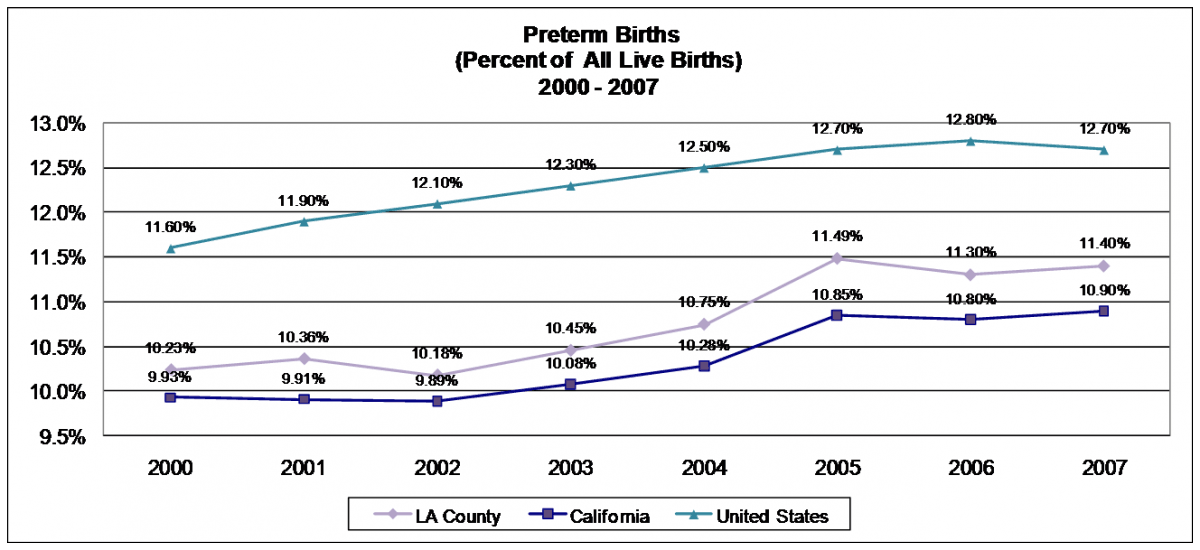Does air pollution in Los Angeles County increase the risk of pre-term birth by 30 percent?
Here’s the media release description of the study and results:
A Californian-based study has looked in detail at air quality and the impact of traffic-related air pollution on premature birth. Published in BioMed Central’s open access journal Environmental Health, results from this study show that traffic-related air pollution, especially polycyclic aromatic hydrocarbons (PAH), is associated with up to a 30% increase in premature births, and that seasonal changes and vicinity to the coast affected concentration of toxic pollutants in the air.
The study, based at the University of California, looked at 100,000 births, within a five mile radius of air quality monitoring stations. The study evaluated births spanning a 22 month period from June 2004, and used information provided by the California Department of Health about the births and the mothers, in addition to air pollution information from monitoring stations which measure concentrations of airborne toxic pollutants.
The researchers were able to analyse and compare exposures using three different information sources: government “criteria pollutant” monitoring stations (including carbon monoxide, nitrogen dioxide, ozone, and fine particulate matter), a traffic pollution model (Land Use Regression), and data about toxic chemicals collected by the South Coast Air Quality Management District. Once integrated, these data provided a new level of detail about the concentrations and location of individual pollutants. All statistical models were adjusted for maternal age, race/ethnicity, education and parity.
Some pollutants were area specific, relating to industry and urbanization. However, overall exposure to critical pollutants such as PAH resulted in up to a 30% increase in the risk of premature birth. Other toxic substances, such as benzene and fine particulate matter from diesel fumes were associated with a 10% increase, while ammonium nitrate fine particles were associated with a 21% increase in premature birth. Concentrations of these pollutants were higher in winter and lower in coastal areas, indicating that local weather patterns played an important part in the dispersal of pollutants.
Dr Beate Ritz said, “Air pollution is known to be associated with low birth weight and premature birth. Our results show that traffic-related PAH are of special concern as pollutants, and that PAH sources besides traffic contributed to premature birth. The increase in premature birth risk due to ammonium nitrate particles suggests secondary pollutants are also negatively impacting the health of unborn babies. To reduce the effects of these pollutants on public health, it is important that accurate modeling of local and regional spatial and temporal air pollution be incorporated into pollution policies.”
Of note in this fatally-flawed weak association epidemiology study, is the fact that the only confounding risk factors for pre-term birth considered by these researchers were maternal age, race, education and parity. Are these really the only risk factors for pre-term birth?
Next, when multi-pollutant analysis was done, essentially none of the statistical associations were significant except for ammonium nitrate PM2.5 — but that one, of course, is subject to the weak association problem.
Also consider the graphs below. Note that:
- Air quality has improved in the Los Angeles area (as represented by the PM2.5 readings from the Riverside monitor (i.e., worst air quality), while pre-term birth rate has slightly increased;
- Los Angeles County’s pre-term birth rate is substantially lower than the U.S. average even though the County has just about the “worst” air in the U.S.
This study does not link pre-term birth with air pollution.


I was born in West Hollywood California in 1941. For those of you who don’t know, this suburb of LA is in the LA basin. In 1960 I drove through LA and tears streamed down my face from the brown smog irritation to my eyes.
I should be dead. How did I every survive the horrific air pollution in the LA basin during these years? The answer is $47,000,000,000,000 dollars later and the air is better, much better. Oh I forgot, I lived through the bad times to start with and wonder how I lived and now the same questions are being raised as if it was 1941.
That is $13,428,286 per person now alive in the U.S. Really? Oh by the way I have a son, daughter-in-law and three wonderful grandchildren. For those interested I will fight to the death for the future of my grandchildren against the tyranny of government at all levels. Of course that would assume voters can not figure out the kind of politicians we need to elect as our representatives. We don’t need to bankrupt our country to save the country.
This could be a minor factor that is drowned out in the total data.
One thing this study does show is that people in areas with high-pollution areas of LA have more preterm births. Could it be that poorer people with less prenatal health care life in more polluted areas? The difference between the crude and adjusted numbers on page 32 look far too small given the statements on the demographics.